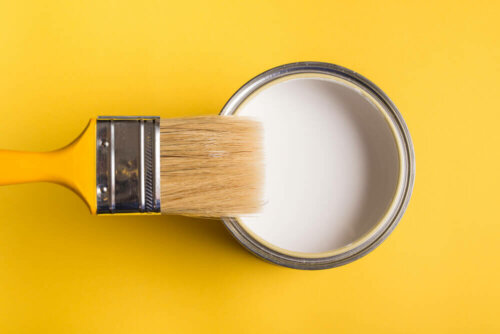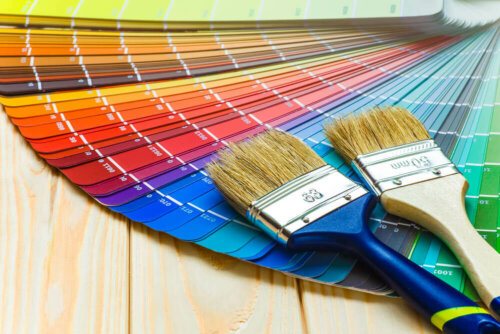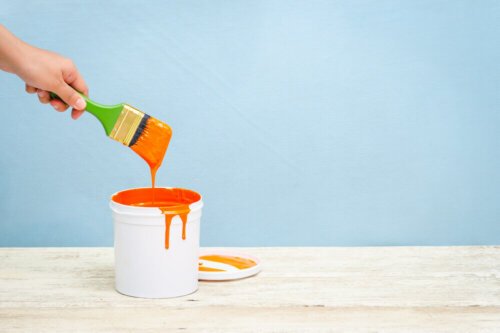The Best Paints for a Healthier Home and Environment

Are you wondering what the best paints for your home are? Have you heard of natural paints? Below we’ll give you a guide to how to choose them. Furthermore, you’ll be glad to know they’re very beneficial for you and your family’s health.
Natural paints don’t contain toxic ingredients and offer the same features as conventional paints. Additionally, they’ll allow the whole house to breathe and let water vapor pass through them.
The best paints for your home – FAQ

Natural paints create a healthy atmosphere indoors without humidity that, can often cause allergies and respiratory problems.
Next, we’ll answer all your questions.
Why use natural paints in your home?
Because, beyond giving color to the walls, paint must be like healthy skin on the walls it covers. Therefore, painting your house with natural paint is the first step to a more livable home.
What’s in them?
Eco-friendly or natural paints use basic ingredients made of vegetables or minerals such as resins, starches, flaxseed or citrus oils, and waxes.
Do they smell?
These types of paint don’t smell like conventional ones that do. This is because the smell from these comes from ingredients derived from petroleum such as formaldehyde, xylene, ketones, or phenols.

Why should I avoid “regular” paints in my home?
Because its components can irritate the skin, eyes and airways. In addition, they can even cause headaches and nausea and are potentially carcinogenic, although there’s no reliable data on this.
Do these paints help with dust?
Surfaces painted with natural products attract less dust as they don’t alter the ion balance in the air (which benefits the body) and the colors are more natural and bright.
Where can I get them?
Some brands are Livos, Keim, Beal, Ecoclay, Embarro, Colorea. You can find other brands on the Sustainable Construction Agency website. Take a look!

Are there special natural paints?
Yes, there are fireproof or metal stain-repellent products, such as Duro 623 by Livos, that is ideal for radiators or pipes, both indoors and outdoors, as it also protects them.
Are water-based paints eco-friendly?
Water-based acrylic or plastic paints, although not the most natural, don’t smell and are breathable. Furthermore, they’re an alternative to synthetic lacquer paints since they have great covering power.
Are “ec0-friendly” paints truly eco-friendly?
Yes, they don’t produce harmful residues since they use a biodegradable and environmentally friendly “soft chemistry”. What more can you ask for…
The best natural paints for your home

Latex paints
These have great covering power but, instead of plastic ingredients, they use plant latex. Also, they’re washable and suitable for painting the kitchen and the bathroom.
Silicate paints
Suitable for painting on lime mortar outdoors and on plaster indoors. Furthermore, they’re very durable, as they don’t actually cover but integrate with the surface material.
Limewash paints
This is a budget-friendly paint that gives you an original finish and it tolerates moisture well. It’s a mix of air lime mortar, pigments and if desired, fine sand. In addition, it can be applied to plaster and cement.
Clay paints
By combining white clay with mineral pigments, protein and vegetable cellulose, you’ll get an excellent paint for interiors. Additionally, it offers a matte, silky and warm appearance.
How to apply the best paints in your home

Don’t be afraid of using natural paint, it’s as easy to apply as conventional paint. Write down the following steps:
- Firstly, remove the old paint for a better result, but without using a paint stripper. Instead, use sandpaper and a mask in order to avoid breathing in dust.
- Remember, do this with all the windows open in order to ensure good ventilation. Often you have to mix the base paint with the pigments so keep in mind they can make this mixture at the store.
- Finally, apply it like conventional paint, if there are no other manufacturer instructions. So, you can start now – grab a good brush and go for it!
As you can see, there are only advantages to this kind of paint. After all, natural paints don’t smell, have no health side effects and offer a wide palette of beautiful colors. So, have you decided to use them in your home? We’d love to know.








